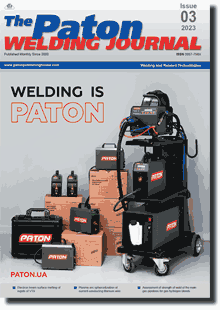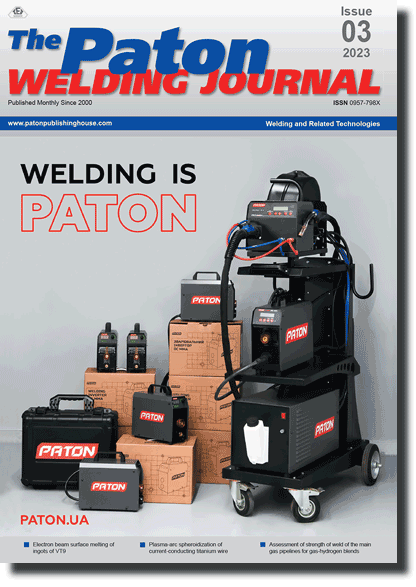
The Paton Welding Journal, 2023, #3, 20-25 pages
E.O. Paton Electric Welding Institute of the NAS of Ukraine 11 Kazymyr Malevych Str., 03150, Kyiv, Ukraine. E-mail: office@paton.kiev.ua
Abstract
Proceeding from the results of the performed package of research work, it was established that the chemical composition of metal in the surface-melted layer of high-temperature titanium alloy VT9 corresponds to standard requirements; and a lowering of aluminium content, an alloying element with vapour pressure higher, and an increase in the content of molybdenum and zirconium, alloying elements with vapour pressure lower than that of titanium, is observed. Investigations of the surface-melted layer showed that the depth of penetration of the surface layer in ingots of high-temperature titanium alloy VT9 of 600 mm diameter reaches 8 mm, the ingot surface is high-quality mirror-like with characteristic vacuum etching, even microrelief without cracks, tears or lacks-of-fusion, its roughness is in the range of 3…4 class at waviness of 0.2…0.6 mm. The surface-melted layer of the ingot has a finer structure, compared to base metal, and it consists of areas with isolated α-plates of 1.0…2.5 μm thickness, where the α-plates are gathered into colonies of 10…50 μm width, and the gaps between them are taken up by dispersed particles of 1…2 μm size, which can be the products of metastable phase decomposition. Ref. 13, Tabl. 1, Fig. 10. products of metastable phase decomposition. Ref. 13, Tabl. 1, Fig. 10.
Keywords: high-temperature titanium alloy; ingot; surface defect; electron beam surface melting; chemical composition; structure
Received: 02.12.2022
Accepted: 24.04.2023
2. Bania, P. (1993) Beta titanium alloys and their role in the titanium industry. Beta Titanium Alloys in the 90's. TMS Publ., Warrendale, PA, 3-14.
3. Cui, C., Hu, B.M., Zhao, L., Liu, S. (2011) Titanium alloy production technology, market prospects and industry development. Mater. Des., 32, 1684-1691. https://doi.org/10.1016/j.matdes.2010.09.011
4. Babenko, E.P., Dolzhenkova, E.V. (2014) Investigation of the causes of destruction of a large-sized product made of VT23 alloy. Metallurgical and Mining Industry, 3, 82-85.
5. Khoreev, A.I. (2007) Theory and practice of development of titanium alloys for promising structures. Tekhnologiya Mashinostroeniya, 12, 5-13 [in Russian].
6. Antonyuk, S.L., Moyar, A.G., Kalinyuk A.N. et al. (2003) Titanium alloys for aircraft industry of Ukraine. Advances in Electrometallurgy, 1, 9-13.
7. Pikulin, A.N. (2016) Electron beam fusion of complexly-alloyed titanium alloys. Sovrem. Elektrometall., 3, 26-30 [in Russian]. https://doi.org/10.15407/sem2016.03.05
8. Koryagin, S.I., Pimenov, I.V., Khudyakov, V.K. (2000) Methods of treatment of materials: Manual. Kaliningrad, Kaliningr. University [in Russian].
9. Krivoukhov, V.A., Chubarov, A.D. (1990 Cutting of titanium alloys. Moscow, Mashinostroenie [in Russian].
10. Paton, B.E., Trigub, N.P., Akhonin, S.V., Zhuk, G.V. (2006) Electron beam melting of titanium. Kyiv, Naukova Dumka [in Russian].
11. Pavlova, T.V., Kashapov, O.S., Nochovnaya, N.A. (2012) Titanium alloys for gas turbine engines. All materials. Encyclopaedic Handbook [in Russian].
12. Khoreev, A.I., Khoreev, M.A. (2005) Titanium alloys, their application and prospects of development. Materialovedenie, 7, 25-34 [in Russian].
13. Aleksandrov, V.K., Anoshkin, N.F., Bochvar, G.A. et al. (1979) Semi-finished products from titanium alloys. Moscow, Metallurgiya [in Russian].
Electron beam surface melting of ingots of high-temperature titanium alloy VT9
The Paton Welding Journal №03 2023 p.20-25
The cost of article: 280 UAH,16 $,15 €. (one article)
AS = «Automatic Welding» - 6 issues per year;
TPWJ = «PATON WELDING JOURNAL» - 12 issues per year;
SEM = «Electrometallurgy Today» - 4 issues per year;
TDNK = «Technical Diagnostics and Non-Destructive Testing» - 4 issues per year.
| 2023 №03 (02) |
DOI of Article 10.37434/tpwj2023.03.03 |
2023 №03 (04) |

The Paton Welding Journal, 2023, #3, 20-25 pages
Electron beam surface melting of ingots of high-temperature titanium alloy VT9
O.M. Pikulin, S.V. Akhonin, V.O. Berezos, A.Yu. Severyn, O.G. Erokhin
E.O. Paton Electric Welding Institute of the NAS of Ukraine 11 Kazymyr Malevych Str., 03150, Kyiv, Ukraine. E-mail: office@paton.kiev.ua
Abstract
Proceeding from the results of the performed package of research work, it was established that the chemical composition of metal in the surface-melted layer of high-temperature titanium alloy VT9 corresponds to standard requirements; and a lowering of aluminium content, an alloying element with vapour pressure higher, and an increase in the content of molybdenum and zirconium, alloying elements with vapour pressure lower than that of titanium, is observed. Investigations of the surface-melted layer showed that the depth of penetration of the surface layer in ingots of high-temperature titanium alloy VT9 of 600 mm diameter reaches 8 mm, the ingot surface is high-quality mirror-like with characteristic vacuum etching, even microrelief without cracks, tears or lacks-of-fusion, its roughness is in the range of 3…4 class at waviness of 0.2…0.6 mm. The surface-melted layer of the ingot has a finer structure, compared to base metal, and it consists of areas with isolated α-plates of 1.0…2.5 μm thickness, where the α-plates are gathered into colonies of 10…50 μm width, and the gaps between them are taken up by dispersed particles of 1…2 μm size, which can be the products of metastable phase decomposition. Ref. 13, Tabl. 1, Fig. 10. products of metastable phase decomposition. Ref. 13, Tabl. 1, Fig. 10.
Keywords: high-temperature titanium alloy; ingot; surface defect; electron beam surface melting; chemical composition; structure
Received: 02.12.2022
Accepted: 24.04.2023
References
1. Niinomi, M. (2011) Recent trends in titanium research and development in Japan. Proc. of 12th World Conf. on Titanium, 1, 30-37.2. Bania, P. (1993) Beta titanium alloys and their role in the titanium industry. Beta Titanium Alloys in the 90's. TMS Publ., Warrendale, PA, 3-14.
3. Cui, C., Hu, B.M., Zhao, L., Liu, S. (2011) Titanium alloy production technology, market prospects and industry development. Mater. Des., 32, 1684-1691. https://doi.org/10.1016/j.matdes.2010.09.011
4. Babenko, E.P., Dolzhenkova, E.V. (2014) Investigation of the causes of destruction of a large-sized product made of VT23 alloy. Metallurgical and Mining Industry, 3, 82-85.
5. Khoreev, A.I. (2007) Theory and practice of development of titanium alloys for promising structures. Tekhnologiya Mashinostroeniya, 12, 5-13 [in Russian].
6. Antonyuk, S.L., Moyar, A.G., Kalinyuk A.N. et al. (2003) Titanium alloys for aircraft industry of Ukraine. Advances in Electrometallurgy, 1, 9-13.
7. Pikulin, A.N. (2016) Electron beam fusion of complexly-alloyed titanium alloys. Sovrem. Elektrometall., 3, 26-30 [in Russian]. https://doi.org/10.15407/sem2016.03.05
8. Koryagin, S.I., Pimenov, I.V., Khudyakov, V.K. (2000) Methods of treatment of materials: Manual. Kaliningrad, Kaliningr. University [in Russian].
9. Krivoukhov, V.A., Chubarov, A.D. (1990 Cutting of titanium alloys. Moscow, Mashinostroenie [in Russian].
10. Paton, B.E., Trigub, N.P., Akhonin, S.V., Zhuk, G.V. (2006) Electron beam melting of titanium. Kyiv, Naukova Dumka [in Russian].
11. Pavlova, T.V., Kashapov, O.S., Nochovnaya, N.A. (2012) Titanium alloys for gas turbine engines. All materials. Encyclopaedic Handbook [in Russian].
12. Khoreev, A.I., Khoreev, M.A. (2005) Titanium alloys, their application and prospects of development. Materialovedenie, 7, 25-34 [in Russian].
13. Aleksandrov, V.K., Anoshkin, N.F., Bochvar, G.A. et al. (1979) Semi-finished products from titanium alloys. Moscow, Metallurgiya [in Russian].
To order the electronic version of the paper:
O.M. Pikulin, S.V. Akhonin, V.O. Berezos, A.Yu. Severyn, O.G. ErokhinElectron beam surface melting of ingots of high-temperature titanium alloy VT9
The Paton Welding Journal №03 2023 p.20-25
The cost of article: 280 UAH,16 $,15 €. (one article)
fill in the form below:
The cost of subscription/purchase order journals or individual articles
| Journal/Currency | Annual Set | 1 issue printed |
1 issue |
one article |
| AS/UAH | 1800 UAH | 300 UAH | 300 UAH | 150 UAH |
| AS/USD | 192 $ | 32 $ | 26 $ | 16 $ |
| AS/EUR | 180 € | 30 € | 25 € | 15 € |
| TPWJ/UAH | 7200 UAH | 600 UAH | 600 UAH | 280 UAH |
| TPWJ/USD | 384 $ | 32 $ | 26 $ | 16 $ |
| TPWJ/EUR | 360 € | 30 € | 25 € | 15 € |
| SEM/UAH | 1200 UAH | 300 UAH | 300 UAH | 150 UAH |
| SEM/USD | 128 $ | 32 $ | 26 $ | 16 $ |
| SEM/EUR | 120 € | 30 € | 25 € | 15 € |
| TDNK/UAH | 1200 UAH | 300 UAH | 300 UAH | 150 UAH |
| TDNK/USD | 128 $ | 32 $ | 26 $ | 16 $ |
| TDNK/EUR | 120 € | 30 € | 25 € | 15 € |
AS = «Automatic Welding» - 6 issues per year;
TPWJ = «PATON WELDING JOURNAL» - 12 issues per year;
SEM = «Electrometallurgy Today» - 4 issues per year;
TDNK = «Technical Diagnostics and Non-Destructive Testing» - 4 issues per year.

